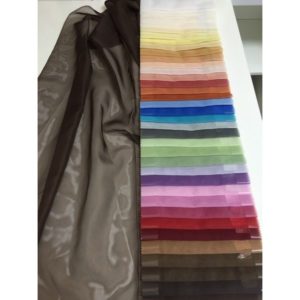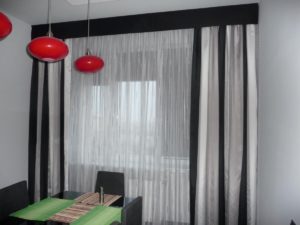Main types of curtains
 Many, if not most, have the habit of confusing curtains with cornices. In fact, curtains are a type of curtains made of transparent or translucent materials. These are the well-known veils, tulles, meshes or organzas.
Many, if not most, have the habit of confusing curtains with cornices. In fact, curtains are a type of curtains made of transparent or translucent materials. These are the well-known veils, tulles, meshes or organzas.
Sometimes they can act as independent window curtains, but most often they are an addition to thicker curtains, since they cannot protect against bright sunlight, but only diffuse it, like tulle.
The colors of the curtains always have soft tones. Often it is just a white shade, but soft blue, light green, beige and other shades are also widespread. The design can be presented either in one solid tone without any additions, or with the inclusion of various drawings. A curtain that combines several soft shades at once also looks harmonious.
The choice of reserves is always taken responsibly.It is necessary to determine in advance how they will be combined with the main curtains, the order of fastening and the type of external design, that is, how they will look. Either they will simply hang down to the floor or some other combination will be applied to them.
The main criteria are:
- According to the shape of the canvas.
- According to the method of arrangement when moving apart.
- According to the method of fixation when picking up the web.
- According to the general decorative style.
- According to the type of material used.
Basic forms of curtains
 The shape is characterized as the main distinguishing feature of curtains. It is considered the most difficult indicator by which their difference from curtains and curtains is determined. Exterior finishes have their own names. Accordingly, they determine the main types of forms. For example, such as:
The shape is characterized as the main distinguishing feature of curtains. It is considered the most difficult indicator by which their difference from curtains and curtains is determined. Exterior finishes have their own names. Accordingly, they determine the main types of forms. For example, such as:
- "Scissors". They are a classic form of curtains. They appear to fall down to the floor with the same length on both sides.
- "Scarves." This is a type of matching long and narrow curtains. With this type, one end of the hanging canvas is lower than the other. Often this decoration technique is used when decorating window openings, simple or figured. In addition, this type is used as heavy curtains.
- Swags. Another name that reflects the type of decorative varieties of curtains. Sometimes this is expressed in complex external forms, sometimes the emphasis is on a simpler device. The only constant requirement is the use of two hanging edges in the design.
- Thiers. This is what small curtains are called. Their purpose is to cover one or more sections of the window opening.
- Canopy. A familiar definition.This type has an exclusively decorative orientation. Such an element is not a curtain and extremely rarely extends even beyond the line of the window.
By the way, in most cases people try to use the classic “scissors” that are familiar to everyone. As for other types, they are used less frequently and, by and large, they are presented mainly as decorative elements that are used as an addition to the main curtains.
Methods for laying fabric
 There are quite a lot of similar methods. When choosing a specific method, you should always be guided by the fact that the curtain ultimately fits clearly into the overall look of the design and suits a specific interior.
There are quite a lot of similar methods. When choosing a specific method, you should always be guided by the fact that the curtain ultimately fits clearly into the overall look of the design and suits a specific interior.
Just like shapes, methods of laying canvases have their own standard definitions. Of course, when searching and purchasing, not everyone is interested in these distinctive values, but for those interested, they are classified under the following names:
- "Rod in pocket." Seems to be the simplest type of installation. When the curtains move apart, they contract on the cornice. When curtaining, the cornice is completely hidden behind the canvas. This installation is more suitable for spacious rooms with several window openings, which provides the room with a high degree of natural light.
- On the eyelets. They look expensive and strict. Judging by the number of eyelets and steps between them, one gets the impression that this structure is either very massive, or, on the contrary, very light. Ultimately, it all depends on the perception of the fabric.
- Tailored pleat. Quite an elegant and unobtrusive way of arrangement. It goes well with heavy types of fabrics, creating a “lightening” effect.
- Clothespin fold. This type of curtain competes with the elegance of the tailored fold, but unlike the latter, it cannot be used in conjunction with dense fabrics.
- Inverted fold. The curtain looks as if it is unfolding the back fold outward. This variety reflects the massiveness of the look and is used in rooms where dark colors dominate.
- "Pencil" fold. Unlike a tailored one, it has a large number of folds located between the rings.
- With cubic folds. Looks like a pencil. The difference is made by the fact that in the corresponding form two rings are used for each fold. With this arrangement, the type of curtain folding is considered less dense.
- The most decorative arrangement seems to be curtains., externally resembling glasses. They are called “curtains with glasses”. They look very impressive. Used as a decorative element in a rich setting.
Basic materials
 As is already known, the main material for the production of curtains is thin translucent fabrics, also distinguished by their respective names.
As is already known, the main material for the production of curtains is thin translucent fabrics, also distinguished by their respective names.
Everyone knows them in everyday life. This is tulle, veil, viscose, silk and other types of lightweight fabrics. Such materials are unpretentious to use and are almost equally applicable to any premises.
The difference in material is taken into account only in the presence of colored shades or creeping fabric. In this case, the best choice would be silk or veil, since they belong to the softest materials.
Options for designer curtain styles
External style is a combination of various options, including decoration, types of fabrics and other defining features of curtains.Some types of styles are reflected in the following names:
- Classic look. The simplest option without any decorative additions.
- French. They assume the presence of such lush elements as lambrequins, festoons and canopies.
- Austrian. Laces and scallops serve as decorative details.
- Japanese. They are vertical sliding panels that do not have folds.
Basic fastening methods
Attaching curtains and blinds in front of the window is done using a cornice. The classification subdivides the methods of installing cornices, and with them the curtains themselves, according to various criteria.
- Wall. Installed on the wall above the window. The most standard installation method.
- Ceiling. Ceiling mounted. At the same time, curtains, visually hanging from the surface of the ceiling, help to visually increase the height of the room.
Choosing curtains for a specific room
 For the living roomAs the largest room, preference will be given to decorative curtains with a large number of folds or other decorations.
For the living roomAs the largest room, preference will be given to decorative curtains with a large number of folds or other decorations.
Small rooms It is best to decorate them lighter and without unnecessary decoration. It is advisable to use the ceiling method of attaching cornices to increase space.
For kitchen It is better to use short types of canvases, slightly extending beyond the bottom line of the window. Just like in the case of a device in a small room, kitchen curtains should have a simple, standard, classic style.
Usually curtains are selected at the same time as curtains. Often they are already on sale as a set. If the purchase takes place separately, then the determining principles are the colors of the curtains, their design and the overall interior of the room.
Installation of curtains on a suspended ceiling
 The name itself already suggests a ceiling mounting method.However, curtains cannot be attached to the tension fabric itself. A special technology is used here.
The name itself already suggests a ceiling mounting method.However, curtains cannot be attached to the tension fabric itself. A special technology is used here.
- The location of the cornice is determined and marked.
- Following the marks, wooden blocks are attached to the ceiling, followed by treatment with an anti-rotting agent.
- When tensioning the ceiling, the places where the bars are attached are highlighted. To make everything look aesthetically pleasing, they are reinforced with special applied and glued rings. The film in the ring is carefully cut out with a paint knife. Screws are screwed into the opened wooden blocks, onto which the cornice and, accordingly, the curtains themselves are subsequently mounted.
Important! The ceiling film should not have folds. It is necessary to monitor the work process and eliminate defects in a timely manner.
Useful advice when choosing curtains
Most people believe that they have a sense of taste and can independently make a good choice. Some people really have this feeling, but many still could use the help of a designer.
A true professional will be able to best resolve the issue of selecting curtains. If contacting a specialist is not financially profitable, the Internet can be an excellent assistant. When addressed to the necessary pages, the attention of those interested will be presented to many catalogs with numerous types of room design.


 0
0





